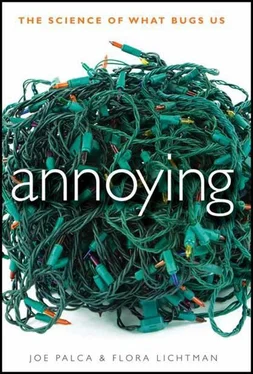For psychiatrists who treat Huntington’s patients, it’s not so much the irritable filter that’s the problem, it’s the expression of the irritability. “As psychiatrists, we don’t deal as much in Huntington’s with the internal state as we do with the external,” says Karen Anderson, who runs the Huntington’s clinic at the University of Maryland. It’s not the patients who complain of feeling annoyed, Anderson says. “It’s the family that sees the external manifestation.”
HD patients with this symptom punch walls and damage property, kick over their children’s bikes, and throw plates at their spouses because dinner was too salty. This is annoyance to the point of dysfunction. This is annoyance as a disease.
Chris Furbee remembers being aware of his mother’s symptoms when he was thirteen and she was in her late thirties. She had movement tics—a subtler version of his grandfather’s swaying. Huntington’s symptoms usually start to appear at this age—around forty. He also remembers his mother acting annoyed: “This is all in hindsight. She seemed to be angry a lot. Back then, I just thought it was my mom being mean. But I think what happened was the disease affected her to the point where she was very irritable.”
Yet Chris says it’s hard to separate the disease from the circumstances. “A lot of that could have been the fact that she was living with her own parents, in this trailer in Philippi, West Virginia—it’s not ideally where she wanted to be,” he says. This is one of the difficulties with measuring irritability as a symptom of a disease. The details of your life make a difference. “It’s easy not to be very irritable if you live in an environment where people don’t impinge on you too much,” says David Craufurd. “Somebody who lives alone, on the whole, tends to be less irritable than somebody who lives with teenage children, shall we say.”
Chris left his mother when he was a teenager. At eighteen, he relocated to the San Francisco Bay area. His grandfather had died. His mom was still driving, showing only mild symptoms, he remembers. He went back a few times, and then years passed without a visit.
• • •
Huntington’s is an inherited disease. Your likelihood of having it is written on the short arm of chromosome four. If one of your parents has the disease, you have a 50 percent chance of inheriting it. If you do not inherit the disease, you cannot pass it on—Huntington’s in your family ends with you.
The gene that causes the disease, technically called IT15, holds the instructions for making the huntingtin protein. What, exactly, the protein does is still a mystery, but it appears to play an important role in nerve cell function. The disease occurs when instructions for the protein are screwed up. Specifically, the gene carrying the instructions includes a sequence of repeating base pairs—cyotosine-adenine- guanine (CAG). Ten to thirty-five CAG repeats on that gene is normal. Thirty-six to thirty-nine puts one at risk for developing the disease. Forty or more repeats, and you will get Huntington’s, with no ambiguity in the prognosis. There is no cure or approved treatment for slowing the disease. Most people die fifteen to twenty years after they start to show symptoms.
The problem with the repeats in the instructions is that they cause the huntingtin protein to be built wrong. “It spoils the shape of the protein, and this has a functional effect of some sort,” says Craufurd. If the language sounds vague, that’s because our understanding of how that malformed protein wreaks havoc on the body and the brain isn’t clear. “There are twenty-five different theories about what the problem is,” says Karen Anderson, “but there is no good solid answer as to what is really going on, which is why we’ve had so much trouble targeting it with the treatment trials.”
Although the mechanism isn’t obvious, the effects are: the busted protein somehow causes muscles to waste away. The liver and the spleen suffer, Craufurd says. HD patients burn calories at a rapid rate, “which sounds wonderful until you realize they also have swallowing problems,” says Anderson. “They can’t possibly eat what most of us eat in a day, let alone enough food to burn four thousand calories in a day, which some of them easily can.”
The brain, however, is the main target of the illness. It shrinks. Brain cells die, and the brain atrophies. One area that suffers the most is the basal ganglia—particularly, the caudate, a primitive section buried deep within the brain. The cerebral cortex also thins out, Craufurd says. “It’s really quite widespread. It’s not uniform throughout the brain. There are some areas where there’s more atrophy than others. You can see that cortical atrophy starts quite early.”
Like a domino effect, when one area of the brain dies, the connections from that area to other places die as well. Karen Anderson says, “As a result of the caudate dying, all of these connections to the frontal lobe and other parts of the brain also die off.”
Brain-imaging techniques such as PET (positron emission tomography) scans and fMRI (functional magnetic resonance imaging) are helping researchers unravel just how the brain deteriorates. If the progression of the disease in the brain could be understood, it’s possible that a symptom like irritability could be tied to particular brain circuitry. At this point, researchers are far from being able to make those connections. “I think that in ten years, we might have a really good answer to that question,” says Karen Anderson. “Right now, we don’t know enough about the progression of brain changes in Huntington’s to be able to answer that.” Anderson says it’s likely that different patients will exhibit different patterns of cell death. “My thought is that there are some groups where the frontal cortex—the areas that control motivation—die out more. In others, there’s circuitry that affects irritability, and those may die out more.”
This is consistent with how the disease manifests. HD affects different people in different ways. Not all patients are irritable. Chris’s grandfather, for example, didn’t seem to show signs of irritability.
Chris went back to West Virginia when he was twenty-eight. When he walked into the house, “it looked like a tornado had hit,” he says. Food-encrusted plates and cups of milk that had been sitting out for days littered the counters. Cigarette burns pocked the carpet. A woman was lying limply on the couch. Her cheeks were sunken. Her hair was a mess. Her body was skeletal. She wasn’t moving. Chris wasn’t sure whether she was breathing. He walked into the kitchen to look for his mother. When he walked back into the living room, the woman on the couch opened her eyes and smiled at him. He left the house and broke down.
Chris also brought a video camera on this trip. He had the idea to do a documentary on Huntington’s disease, although, he says, “I had no idea what I was going to shoot, until I got there.” Chris couldn’t bring himself to film the house when he first got home. He regrets that. He did set up a “makeshift studio in one part of the garage” and used it to do self-interviews. He shot twenty hours of footage in the two months that he stayed with his mom. During the last fifteen years, he has relived that period of his life again and again while editing the tape. As you might suspect, he says, “It is painful to watch that footage over and over.”
Chris’s mom, despite the severe chorea, refused to admit that she had the disease. She had told Chris that if she ever started to show signs of the illness, she would kill herself. So Chris never got to talk to his mom about the disease. The denial also complicated the filming—“I couldn’t just say to her, ‘Hey, Mom, I’m doing a documentary on Huntington’s disease,’ because she never admitted that she had it, and any time I would bring up Huntington’s disease, she would start talking about suicide. That was a conversation I never wanted to have with my mom.”
Читать дальше












